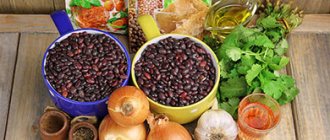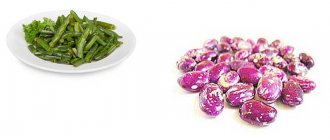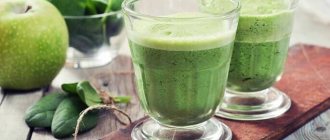Chemical composition of canned beans
The culture of the legume family contains a large number of useful elements, containing almost the entire periodic table.
It is rich in content:
- Sodium;
- Potassium;
- Calcium;
- Magnesium;
- Copper;
- Gland;
- Zinc.
This is a highly fortified product, including vitamins B, A, C, E, PP. Beans are rich in healthy fiber and proteins, which are building blocks for the body. The culture is saturated with amino acids important for human health, which enhance its beneficial properties.
Calorie content and nutritional value of beans per 100 g:
| Product name | Proteins, g | Fats, g | Carbohydrates, g | Call |
| White | 7 | 0,5 | 16,9 | 68,8 |
| Red | 21 | 2 | 46 | 99 |
Composition and calorie content of beans
Beans contain proteins, fats and carbohydrates, nutrients, microelements, vitamins, and amino acids.
The protein contained in beans is easily digested, and in terms of protein content, beans are close to dietary meat - 100 g of beans contains more than 20 g of proteins. It also contains starch and other carbohydrates (about 50% of the volume), fiber (12-12.5%), and some fat (about 2%). The main source of calories in beans is carbohydrates, followed by proteins . The fat content in this product is quite low, and during the cooking process (cooking, stewing) the fats are partially digested from the bean grains.
The calorie content of dry red beans is 298 kcal per 100 g. When cooked, the beans increase in size by 2-2.5 times. The calorie content of boiled red beans is 123-127 kcal per 100 g. The calorie content of red beans is lower than that of white beans, but their composition is quite similar.
Of all types of beans, green beans have the lowest calorie content. It is the easiest to digest due to the fact that it contains more fiber (which is not absorbed by the body, but is released naturally, while simultaneously cleansing the body of toxins and waste) and less protein. They contain more vitamins than other types of beans and more water. The calorie content of green beans is 29-34 kcal per 100 g. Due to its low calorie content, green beans are recommended as a dietary dish for weight loss.
Canned beans are also a popular dietary product. The calorie content of canned beans depends on the type (red or white) and method of preparation, but on average it does not exceed 100 kcal per 100 g. For example, the calorie content of canned beans in tomato sauce is 79-82 kcal per 100 g .
What are the benefits of canned beans?
The benefit of canned beans is that even after canning they remain a good antioxidant. This is indicated by the high content of amino acids in the culture, thanks to which it has healing properties. Before mentioning the endless benefits of canned white beans, it is worth clarifying that they can also cause harm, albeit in very rare cases. Most often this occurs with personal intolerance, diseases of the duodenum and stomach. Among the beneficial properties of white beans, it should be noted that they:
- improves the functioning of the central nervous system;
- takes an active part in hematopoiesis;
- normalizes the functioning of the cardiovascular system;
- normalizes glucose levels in blood cells;
- removes excess salts from the body;
- relieves inflammation;
- helps in the fight against viruses and microbes;
- improves intestinal microflora;
- has rejuvenating properties;
- strengthens bone tissue, teeth, nails.
The beneficial properties of the white variety are enhanced if vegetables rich in vitamin C are added to the diet along with it.
Canned red beans have no less benefit and minimal harm, 75% of their components are easily digestible protein. In terms of protein content, the red variety ranks alongside meat and fish. Consuming the product strengthens the immune system.
Thanks to the healing properties of red beans:
- increases hemoglobin;
- normalizes metabolism;
- normalizes the digestion process and the functioning of the gastrointestinal tract;
- is a diuretic that removes kidney stones;
- Thanks to starch, it charges the body with energy;
- removes toxic substances and waste;
- prevents anemia.
The white and red varieties combine a large amount of protein and beneficial amino acids. This highly nutritious crop is an excellent meat substitute for vegetarians.
The benefits of canned beans
Canned beans are quite beneficial for human health. Beans in cans and glass jars are primarily a source of building material and energy. Therefore, the canned product has found wide use in dietary nutrition for various diseases, as well as in the diet of people losing weight. High calorie content is not a hindrance - on the contrary, it even helps to get rid of excess weight, since canned beans give the gourmand a feeling of fullness that comes from eating a small amount of beans.
The presence of fiber in canned food allows you to solve problems in the gastrointestinal tract. Dietary fiber from beans helps cleanse the body of waste and toxins, helps develop beneficial intestinal microflora, enhances intestinal motility, combating chronic constipation.
B vitamins contained in canned treats protect the cardiovascular and nervous systems from serious diseases and eliminate disruptions in their functioning. These biologically active substances also have a positive effect on the skin - and in tandem with vitamin E. The latter, by the way, also prevents the development of female infertility.
Canned beans normalize metabolism in the body, mainly protein and carbohydrate. Regular consumption of them helps reduce the level of “bad” cholesterol in the blood. Including canned beans in your diet will help to some extent avoid cancer, since the product contains antioxidants (tocopherol, zinc, etc.) and eliminate inflammatory processes. Beans are responsible for hematopoiesis, maintaining good hair condition, normal hemoglobin levels in the blood, excellent appetite, restoration of soft tissues and epidermis. Canned beans are an excellent diuretic, expectorant and sedative. In general, we are dealing with a real natural health resort, which can and should be used in our daily life.
Are there any benefits to canned beans with additives?
Healthy legumes can be preserved in several ways. On store shelves you can see different varieties of beans in tomato sauce: white and red, with the addition of vegetable oil or vinegar, in their own juice. The canned beans themselves do not lose their benefits. The beneficial qualities are best preserved when the canned beans contain, in addition to the product, only water, salt and sugar. The benefits of beans in tomatoes remain, without increasing their calorie content. Other industrial additives may be harmful to health.
Properties of canned beans in tomato sauce
How much does canned beans in tomato sauce cost (average price per 1 kg)?
Moscow and Moscow region.
110 rub.
Beans are the most valuable natural source of such a useful element as protein. It is not only healthy, but also extremely tasty if prepared correctly and served appropriately. Beans are not only soaked, boiled, and then used in the preparation of numerous dishes, but also canned. Moreover, canned beans in tomato sauce are especially popular.
Canned beans in tomato sauce are a necessary ingredient in many dishes: appetizers, salads, soups, and they can also be used as an excellent side dish for meat dishes and even pate. That is why a jar of canned beans in tomato sauce, which a thrifty, insightful housewife always has, is sometimes so indispensable.
To ensure that the choice of canned beans in tomato sauce goes as planned, first of all we look at the composition of the product. The shorter it is, the better: beans (white or red), water, tomato paste, granulated sugar, table salt. As for preservatives: according to the standard, only one ingredient can act in this capacity - acetic acid. Food coloring should not be used. However, unscrupulous manufacturers may use these additives, especially if they produce the product according to specifications.
In addition, canned beans in tomato sauce contain various flavoring additives, most often ground black pepper, garlic, onions and all sorts of spices. In addition, for greater thickness, manufacturers sometimes add flour.
By the way, experienced buyers prefer a glass jar to a tin jar - such canned beans in tomato sauce have no secrets from you. The shapes and sizes of beans are regulated by the state standard. The length of the beans varies from 9 to 16 mm, and the thickness - from 5 to 6.5 mm. And this is not without reason: large beans take one and a half times longer to boil than small beans - if they are calibrated incorrectly, toxins will remain in the large ones. Small ones may boil over.
It is worth noting that, unfortunately, GOST standards for canned beans in tomato sauce are not provided, so here it is better to rely on yourself and your instincts. Starch (in particular, modified E1422) is undesirable in the composition, but vegetable oil is a good additive. This way, canned beans in tomato sauce become a healthier product, since it contains proteins and carbohydrates, and oil contains fats. That is, in the end the product becomes complete.
The color of canned beans in tomato sauce matters. White beans are a champion in calcium and magnesium content - they are the ones who take care of the strength of our bones and teeth. And red is rich in valuable fiber, which can remove harmful toxins from the body.
Canned beans for pregnant and lactating women
The benefits of canned beans are also significant for the body of pregnant women. The magnesium, calcium and potassium it contains contribute to the proper development of the fetus, and vitamins, especially group B, strengthen the health of the expectant mother. Fiber normalizes the digestion process and metabolism, failures of which often occur in pregnant women.
The grains are also useful for breastfeeding. But they need to be introduced into the diet in small quantities and it is better after the child is 5-6 months old, so that his stomach has time to get stronger. When consuming legumes during lactation, it is important to monitor the baby’s condition: after all, their consumption, especially in excess, can provoke bloating and increased gas production.
The benefits of canned beans
The benefit of canned beans, as well as the main raw material for its production, is the presence of a large amount of nutrients. It has been scientifically proven that, despite the special heat treatment process, up to 80 percent of the original minerals and 70 vitamins are retained in the product in this form. However, if you care about your figure, even regardless of the low calorie content of canned beans, you should opt for a product that is prepared without the use of animal fats.
Be that as it may, when consuming any legumes, you must observe moderation, otherwise the benefits of canned beans may result in possible harm. First of all, you should remember that this product takes at least four hours to digest, so it can cause flatulence.
Canned beans for children
Pediatricians do not recommend giving canned bean treats to children under three years of age. It should be introduced into the child’s diet gradually and not as an independent dish, but as an additive to soups, stews, and grated porridges. There is no need to give children the product more than twice a week: the daily norm should be about 100 g. A small stomach does not absorb the culture well, which can lead to flatulence in the baby. Therefore, despite the mass of healing properties, it is not worth giving beans to children at an earlier age, so as not to cause unnecessary harm to the body.
What can you make from canned beans?
You can prepare many different festive and Lenten dishes from canned beans. The product is well compatible with meat, vegetables and mushrooms. Beans stewed with tomato paste are delicious. Soups, stews, and salads are prepared with them. After mashing the fruits into puree, they are added as a filling to casseroles, pies and pies.
Salad with canned beans
Ingredients needed to prepare the salad:
- canned red beans – 200 g;
- red onion – 1⁄2 pcs.;
- pickled cucumber – 100 g;
- egg – 2 pcs.;
- sour cream – 2 tbsp. l.;
- parsley - 3 - 4 sprigs;
- salt, pepper to taste.
Cooking steps:
- Cut the onion into cubes or rings and pour boiling water over it for 2 - 3 minutes.
- Boiled eggs and cucumbers are also cut into cubes.
- Place all ingredients in a bowl, adding previously drained beans.
- Mix thoroughly, season with sour cream and spices.
- Chop the parsley, add to the salad and stir well again.
The amount of ingredients is calculated for two servings of salad.
Omelette with canned beans
- Cut onions and tomatoes into rings.
- Fry them in olive oil.
- Beat 4 eggs.
- Add 1 tbsp. l. cream, salt and sweet ground pepper.
- Once the tomatoes are soft, add 2 tbsp. l. white bean fruits.
- Pour in the egg and cook over low heat, covering with a lid.
- Sprinkle the browned omelette with grated cheese and turn off the stove.
- Cover the dish with a lid to melt the cheese a little.
Recommended reading: Benefits of tomatoes for the body
Application
Canned red beans are a ready-to-eat product. It does not need to be pre-soaked and cooked. Canned beans are used as an appetizer, as a side dish, and added to salads and soups shortly before the end of cooking. Red beans are also added to casseroles, pizzas, and meat stews. It goes well with hot seasonings, especially chili peppers and garlic. One of the best combinations is red beans and rice.
Red beans sealed in jars can be stored for up to five years; if opened, they can be stored for 2-4 days in the refrigerator.
Market Analytics
- COVID-19 is changing the rules of the game in the cosmetics market
- Beauty of the future: cosmetic innovations 2020
- New ingredients are the driving force of the cosmetics industry
Convenient search for beauty salons on our website
Beauty salons in Moscow Beauty salons in St. Petersburg Beauty salons in Ekaterinburg Beauty salons in Novosibirsk
Latest blog posts on our website
- Naturecream / Geranium (Pelargonium) oil for skin health and beauty
- Prostye-sovety / Save on a beauty salon: procedures that can be done at home
- Naturecream / Growth Factor - brings back youth?
- Oksana-Lezina / 3 effective abdominal exercises from a fitness instructor for beginners
- Prostye-sovety / Making perfect curls at home
- Prostye-sovety / Which hair removal method to choose
- Naturecream / Wrinkles Puppets
- Naturecream / PEPHA-TIGHT - instant skin lifting
- Naturecream / Blue light - a danger to the skin
- Naturecream / Cocoa Butter – A treat for the skin
Latest forum topics on our website
- Mrs._Smith / Badly sunburned! What to do?((
- Ice / Is it necessary to combine fitness classes with a diet?
- Antonova / What can be used for hair loss?
- Radio operatorKat / Who was on a protein diet?
- Suzanna / Mesotherapy on the face
Other articles in this section
| White beans White beans belong to the type Common beans. The homeland of beans is Peru, from where the plant spread throughout South and Central America. In the 15th century Spanish travelers brought beans from the New World to Europe. White beans, like other legumes, have exceptional nutritional value and are especially beneficial for vegetarians. |
| Carrots Although fresh carrots can be found in markets throughout the year, the vegetable is most beneficial when it is in season—summer and fall. The usual appearance is an orange root vegetable, but carrots are also found in white, yellow, red and even burgundy colors. Until the XV-XVI centuries. Only red varieties of carrots were cultivated; the orange variety appeared later. Due to the content of provitamin A, this vegetable is used to prevent eye diseases and improve vision. |
| Beetroot The homeland of wild beets is located in North Africa, where they began to grow in prehistoric times. Then people ate only beet leaves, and the ancient Romans were the first to use the root crop for food. Thanks to them, beets spread throughout Europe. Beetroot became especially popular in the 19th century, when it was discovered that this vegetable could replace sugar cane in terms of sugar content. Beetroot is a beautiful red-violet root vegetable with a sweet taste. |
| Radishes Radishes belong to the cruciferous family. This small, bright pink root vegetable begins to bear fruit in the spring. Radishes are early-ripening vegetables; several harvests can be harvested in one season. It has an easily recognizable pungent taste. |
| Purple Potatoes Purple potatoes are a type of sweet potato. Its homeland is the tropics of South America. It is sometimes called Japanese because purple potatoes have been an important part of the daily diet of Okinawans for centuries. |
| Red lentils Lentils are one of the first plants that humans began to cultivate for food. It belongs to the legume family and is an oval-shaped seed enclosed in a pod. Typically a pod contains 1-2 seeds. Lentil dishes are especially popular in Middle Eastern and Asian cuisine (Chinese, Indian) due to their high nutritional value. |
| Grape leaves Grape leaves have been an integral part of Greek, Turkish, Romanian and Vietnamese cooking since ancient times. They are dark green vegetables, which are recommended to be included in the diet at least 100 g per week. |
| Chard Chard is a leafy green vegetable. The Mediterranean region is considered its homeland. Even the ancient Greeks and Romans wrote about the healing properties of chard. All parts of the plant are edible. |
| Roasted Cauliflower Like other types of cabbage, cauliflower is descended from wild kale. Since ancient times, it has been grown in the Mediterranean region. The head of cauliflower is formed from small, densely grouped white buds. There are also varieties in green, orange and purple. Cauliflower loves moderate climates and fertile, moisture-rich soil. |
| Beans Beans are the fruits of various plants of the legume family. These include lentils, soybeans, different types of beans and peas - in total more than 13 thousand plant species. Despite their small size, beans contain many nutrients, especially proteins. Beans are native to the Mediterranean and are a traditional crop in Greece. Due to their nutritional value, legumes are distributed throughout the world. Thus, in China, more than half of all cultivated land is devoted to legumes. |
Harm of canned beans and contraindications
With a large number of useful qualities and healing properties, canned beans can cause harm to the body.
It's possible:
- with individual intolerance;
- in case of allergy to fruits;
- for diseases of the gastrointestinal tract, kidneys and liver diseases.
You should also exclude legumes from your diet if you have:
- ulcers, gastritis and other intestinal diseases;
- increased acidity;
- metabolic diseases such as gout;
- with flatulence.
To avoid possible harm, it is better to avoid eating canned beans in the early stages of pregnancy.
How to choose canned beans
When choosing canned beans, you should pay attention to ensure that they are manufactured in accordance with GOST. It is important to study the composition, condition of the jar and the quality of the brine.
- The composition must contain legumes, water, salt, sugar and acceptable spices. All other additives reduce the quality of beans, and some can even be harmful to health.
- The jar must be intact, without dents or other damage.
- The beans in the jar should be the same size. The presence of large and small fruits in one jar is unacceptable. In this case, during heat treatment, small beans will be boiled, but large ones will not be cooked. When undercooked, toxins harmful to the body remain.
- The brine of high-quality beans should be cloudy. Its amount should be no more than 40% of the total weight of the contents of the jar.
And, of course, it is important to pay attention to the date of manufacture and shelf life of the product.
How to store canned beans
Basically, legumes are canned and sold in tin cans, which are hermetically sealed and do not allow oxygen to enter. But after opening, the air begins to interact with the metal, which leads to oxidation and the product deteriorates.
Manufacturing companies use jars with a varnished inner surface for canning, due to which the oxidation process slows down. In them, beans can be stored for no more than a day in the refrigerator. To keep its fruits for several days longer, they should be transferred to a glass, plastic or porcelain container, which must be closed with a lid. This way the shelf life can be increased to 3 days.










